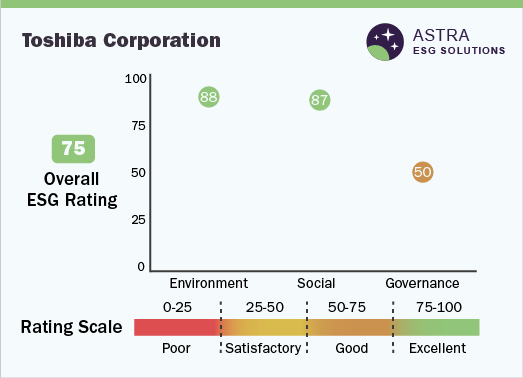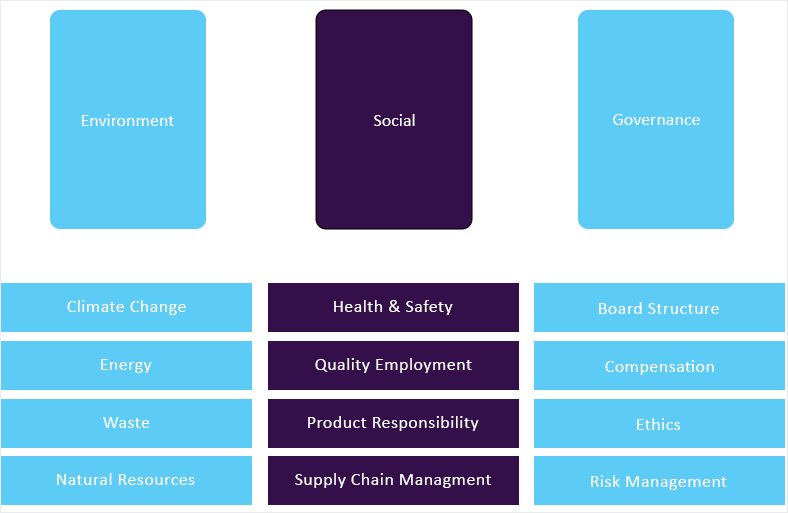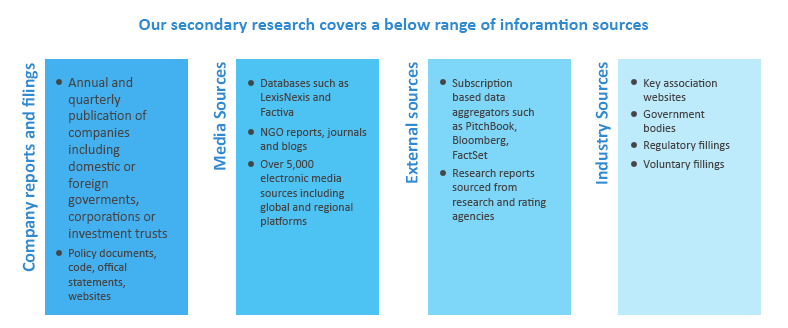Compliance, ESG Challenges & Framework, ESG Trends
- Report Summary
- Methodology
- Request for ESG Consultation
Environment, Social and Governance (ESG) at Toshiba Corporation
Toshiba is a Japanese multinational conglomerate corporation headquartered in Minato, Tokyo, Japan, established in 1935. Currently, it ranks number 97 on FORTUNE 500 companies list.
The company has been focusing on sustainability due to effective due diligence and better investment decision for the company as well as relevant stakeholders. The company is closely working and updating its progress on climate change and circular economy. Moreover, the company gives respect for human rights, nurtures people and technology, encourages every group of employees to feel pride and fulfillment in their work, and harnesses creativity and technology in collaborating with business partners to realize rich value. On the governance front, the company has to strengthen governance and cyber resilience. The company aims to improve its operations with respect to the United Nations’ Sustainable Development Goal (UNSDG) framework.
ESG Trends
The company has various ESG trends around innovation, for example, SCiB™ rechargeable battery which is highly safe has a long lifetime, and recharges fast has been developed to improve the product performance, thereby improving social product responsibility. SCiB™ helps reduce fuel consumption as well as reduce CO₂ / NOx emissions, reduces life cycle costs and improves operating rates, saves space in battery systems, and enables the construction of highly safe and reliable battery systems which also contributes to reduced emissions and improved environmental sustainability.

The company’s power electronics wing has been focusing on environment like using MOSFET’s, silicon carbide (SiC)- a new material optimized for low-loss and miniaturization of power converters for the industry, such as inverters and converters for railway vehicles and photovoltaic inverters. In terms of health and safety, Toshiba Corporation has been able to reduce its injury rate across the company’s group operations since 2019. Furthermore, in terms of diversity and inclusion, the company has targets to achieve diversity within its operations through a structured approach through in-house training and community development initiatives. The company also aims to achieve a fair representation of women across its workforce which has marginally increased compared to 2019. The company also aims to provide a flexible work system and promotes this through initiatives.
Future of ESG at Toshiba Corporation
In 2021, Toshiba Corporation’s revenue was USD 28.37 billion. The company envisions various aspects including sustainability as one of the main agenda, with promising innovation and product development side supporting sustainability, the company have a favorable future ahead.
Research methodology
Grand View Research (GVR) employs a holistic and robust research methodology focused on delivering precision. Our ESG key issues are selected following a thorough materiality analysis run by our taxonomy committee. We examine leading business journals relevant to the industry sector and where applicable references are made to a range of sources including regulatory agencies, trade associations, company filings, white papers, and analyst reports during the due diligence on data aggregation. In addition, a recurring theme that remains central to all our research reports remains data triangulation which aims to dive into the market from thematic context, regulation, and industry benchmarking, including SWOT analysis.
Eligibility Criteria and Company Selection
Each public company is curated by our senior researchers following a comprehensive study of their business involvement around a specific theme. The involvement extends to subsidiaries based on at least 50% holding by the parent company. Following this, we analyze fundamental financial indicators, including revenue and market capitalization to ensure a diverse set of companies that fairly represent the sector are included. Additionally, GVR researchers ensure the disclosure level of each company across the material ESG key issues.
Scoring Methodology
Each ESG metric is assigned a specific weight based on its relevance across sectors. Below are the aggregated weights across pillars, which are derived from each metric.
| Environment | Social | Governance |
| 40% | 30% | 30% |
GVR’s proprietary ESG score is calculated using a weighted average method at:
• Key issues level
• Pillar level
• Company level and,
• Theme level
Data Mining
Data is obtained and collated from diverse source points. The data collected is continuously cleansed to ensure that only validated and verifiable sources are analyzed. In addition, data is also mined from a large number of in-house syndicated research reports inventory as well as through paid databases and premium content. During this research report, we conducted multiple primary interviews across the globe supported by our Primary Research Panels through the delivery of a mix of paid and unpaid interviews. We also send and receive responses from a wide section of industry participants through a carefully crafted and comprehensive survey questionnaire. We triangulate these data into quant models and generate qualitative insights. Evolving industry dynamics that shape drivers, restraints, and pricing are also gathered. As a result, the published content includes proprietary data and meaningful insights.
Fundamental ESG data:
GVR’s ESG taxonomy committee maintains the framework and ensures it is updated quarterly considering market updates and relevance. Framework includes 65+ fundamental ESG metrics that are identified following a thorough materiality assessment. Below is GVR’s ESG Level-I framework:

Alternative ESG data:
GVR also analyzes macro-economic factors that impact or drive the growth of respective sectors. This includes
• Deep dive analysis of policy and regulatory landscape that has potential towards shaping the future of businesses
• Innovation quotient of a sector to gauge prospective evolution of a theme and related opportunities
• Investment scenario, including mergers & acquisition, funding and other deals to assess the investment appetite for a particular theme
• Other market activities, including market size, growth forecasts among others.
Information sources



